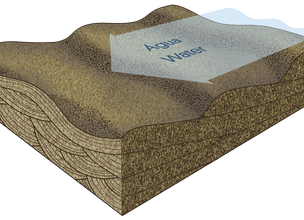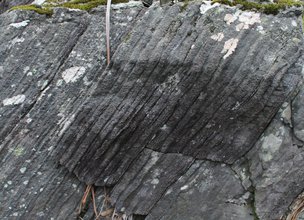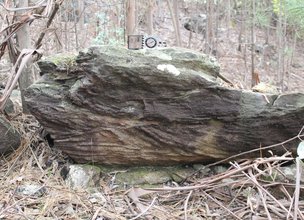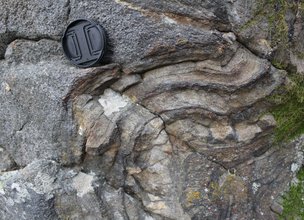Metamorphic rocks of sedimentary origin
In this Local Natural Monument, there are other curious aspects to observe! Let’s check the metamorphic rock that is very near Penedo Furado block.
Although they are close to each other, rocks might be the result of different geological processes with very different ages. Granites in this region formed about 300 million years ago but these metamorphic rocks are even older: they are about 500 million years old! Besides the age difference, they have formed in a completely different way compared with granites (esq. A).
These metamorphic rocks began to be formed when sand (sediments) were transported and deposited by water forming horizontal layers (Fig. 1).
The transport of sediments sometimes gives rise to sand waves that accumulate on top of one another, forming overlapping concave structures called cross bedding (esq. B). Later, these sediments gave rise to a compact and hardened sedimentary rock, imprinted with the record of these sand waves (Fig. 2). Finally, this rock was transformed by heat and pressure into the metamorphic rock that exists today in this place.
In the same place are also visible folds that affect the stratification (Fig. 3). This rock deformation is related to the compressive forces that around 300 million years ago led to: i) closure of the primitive ocean where these and other ancient sedimentary rocks formed, and ii) formation of a mountain range. During this long time span, this mountain range has been eroded but some evidences of its existence are still here!
In this Local Natural Monument, there are other curious aspects to observe! Let’s check the metamorphic rock that is very near Penedo Furado block.
Although they are close to each other, rocks might be the result of different geological processes with very different ages. Granites in this region formed about 300 million years ago but these metamorphic rocks are even older: they are about 500 million years old! Besides the age difference, they have formed in a completely different way compared with granites (esq. A).
These metamorphic rocks began to be formed when sand (sediments) were transported and deposited by water forming horizontal layers (Fig. 1).
The transport of sediments sometimes gives rise to sand waves that accumulate on top of one another, forming overlapping concave structures called cross bedding (esq. B). Later, these sediments gave rise to a compact and hardened sedimentary rock, imprinted with the record of these sand waves (Fig. 2). Finally, this rock was transformed by heat and pressure into the metamorphic rock that exists today in this place.
In the same place are also visible folds that affect the stratification (Fig. 3). This rock deformation is related to the compressive forces that around 300 million years ago led to: i) closure of the primitive ocean where these and other ancient sedimentary rocks formed, and ii) formation of a mountain range. During this long time span, this mountain range has been eroded but some evidences of its existence are still here!

Esq. A - Three hundred million years ago, metamorphic rocks surrounded the magma which originated the granite of Penedo Furado.

Esq. B - Development of cross bedding due to the transport of sediments.
Location
Monte Meadela
Coordinates
Lat: 41.7219227
Long: -8.8119861
Hello little one!
I'm Piquinhos and I can help you learn more about the Geopark!
Technical details
Esq. A - Three hundred million years ago, metamorphic rocks surrounded the magma which originated the granite of Penedo Furado.
Esq. B - Development of cross bedding due to the transport of sediments.
Child Mode
Discover the geopark in a simpler format, aimed at the little ones.
Clique ENTER para pesquisar ou ESC para sair


